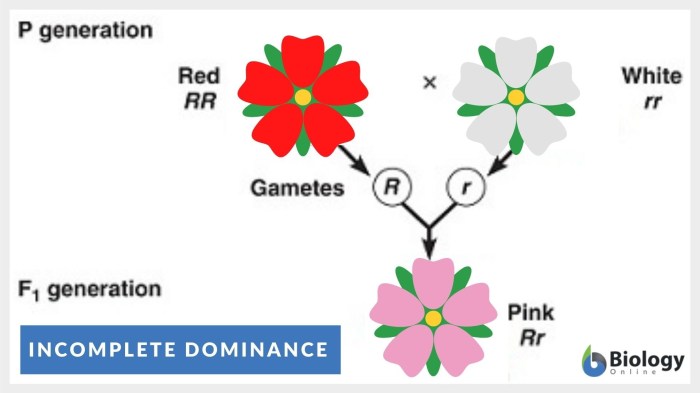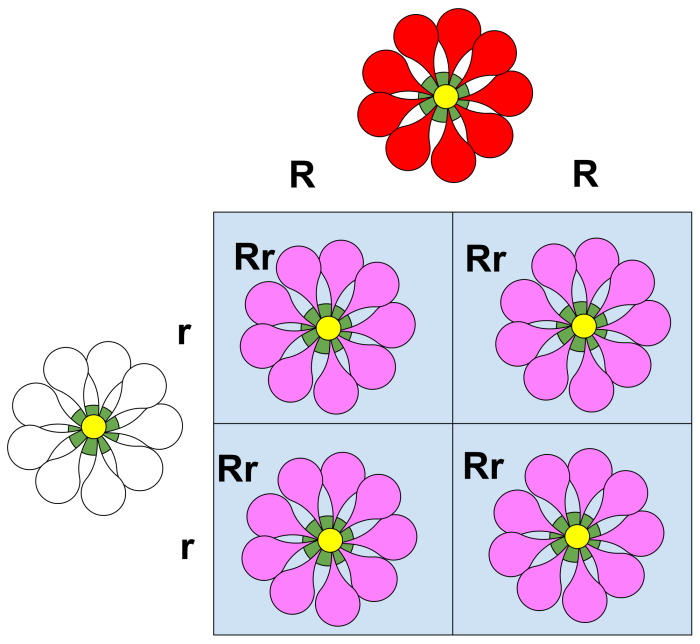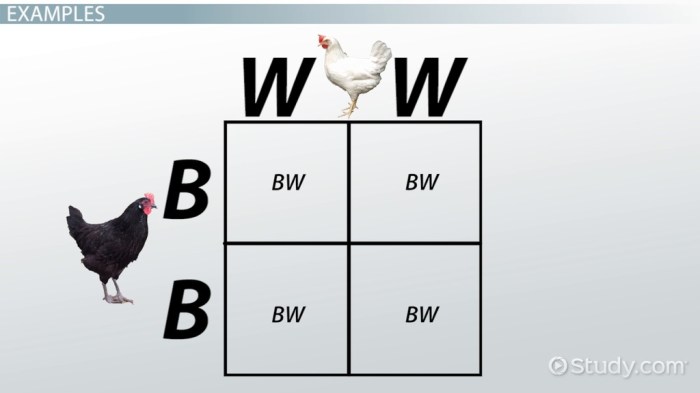Genetics punnett squares and incomplete vs codominance answer key – Embark on a captivating exploration of genetics through the lens of Punnett squares, uncovering the intriguing concepts of incomplete dominance and codominance. This comprehensive answer key unravels the mysteries of genetic inheritance, providing a roadmap to understanding the complexities of gene expression.
Delve into the intricacies of Punnett squares, unraveling the secrets of genetic inheritance. Discover the fundamental principles of incomplete dominance, where alleles blend their effects, and codominance, where both alleles fully express themselves. Through real-world examples and insightful explanations, this guide illuminates the fascinating world of genetic variation.
Punnett Squares

Punnett squares are a tool used to predict the possible genotypes and phenotypes of offspring from a particular genetic cross. They are based on the principles of Mendelian inheritance, which states that genes are passed down from parents to offspring in a predictable manner.
To create a Punnett square, you first need to know the genotypes of the parents. The genotype is the combination of alleles for a particular gene that an individual has. For example, a person with the genotype Aa for the gene that controls eye color has one allele for brown eyes (A) and one allele for blue eyes (a).
Once you know the genotypes of the parents, you can create a Punnett square to predict the possible genotypes and phenotypes of their offspring. The Punnett square is a grid with the genotypes of the parents listed on the sides.
The possible genotypes of the offspring are listed in the squares of the grid.
For example, the Punnett square below shows the possible genotypes and phenotypes of offspring from a cross between two parents with the genotype Aa for the gene that controls eye color.
“`| | A | a ||—|—|—|| A | AA | Aa || a | Aa | aa |“`
As you can see from the Punnett square, the possible genotypes of the offspring are AA, Aa, and aa. The possible phenotypes of the offspring are brown eyes (AA and Aa) and blue eyes (aa).
Incomplete Dominance

Incomplete dominance is a type of inheritance in which the heterozygous genotype has a phenotype that is intermediate between the phenotypes of the homozygous genotypes. This is in contrast to complete dominance, in which the heterozygous genotype has the same phenotype as one of the homozygous genotypes.
An example of incomplete dominance is the inheritance of flower color in snapdragons. The homozygous genotype for red flowers (RR) produces red flowers, the homozygous genotype for white flowers (rr) produces white flowers, and the heterozygous genotype (Rr) produces pink flowers.
Incomplete dominance is caused by the fact that the alleles for a particular gene do not completely mask the effects of each other. In the case of snapdragons, the allele for red flowers does not completely mask the effects of the allele for white flowers, resulting in the intermediate phenotype of pink flowers in the heterozygous genotype.
Codominance

Codominance is a type of inheritance in which both alleles of a gene are expressed in the heterozygous genotype. This is in contrast to incomplete dominance, in which the heterozygous genotype has a phenotype that is intermediate between the phenotypes of the homozygous genotypes, and complete dominance, in which the heterozygous genotype has the same phenotype as one of the homozygous genotypes.
An example of codominance is the inheritance of blood type in humans. The ABO blood group system is controlled by three alleles: A, B, and O. The allele A codes for the A antigen, the allele B codes for the B antigen, and the allele O codes for no antigen.
The possible genotypes for the ABO blood group system are AA, AO, BB, BO, and OO. The possible phenotypes are type A blood (AA and AO), type B blood (BB and BO), type AB blood (AB), and type O blood (OO).
In the case of codominance, both alleles of a gene are expressed in the heterozygous genotype. This means that individuals with the genotype AB have both the A and B antigens on their red blood cells, resulting in the type AB blood phenotype.
Answer Key

Punnett square problem involving incomplete dominance:
A snapdragon plant with red flowers (RR) is crossed with a snapdragon plant with white flowers (rr). What are the possible genotypes and phenotypes of the offspring?
Answer:
The possible genotypes of the offspring are Rr and rr. The possible phenotypes of the offspring are pink flowers (Rr) and white flowers (rr).
Punnett square problem involving codominance:
A human with blood type A (AA) is crossed with a human with blood type B (BB). What are the possible genotypes and phenotypes of the offspring?
Answer:
The possible genotypes of the offspring are AB and AO. The possible phenotypes of the offspring are type AB blood (AB) and type A blood (AO).
Table summarizing the key differences between incomplete dominance and codominance:
| Characteristic | Incomplete Dominance | Codominance |
|---|---|---|
| Phenotype of heterozygous genotype | Intermediate between homozygous genotypes | Both alleles are expressed |
| Example | Flower color in snapdragons | Blood type in humans |
Expert Answers: Genetics Punnett Squares And Incomplete Vs Codominance Answer Key
What is the difference between incomplete dominance and codominance?
Incomplete dominance occurs when neither allele is fully dominant, resulting in a blended phenotype. Codominance, on the other hand, occurs when both alleles are fully expressed, leading to a distinct phenotype.
How can Punnett squares be used to predict the probability of inheriting a specific trait?
Punnett squares provide a visual representation of the possible combinations of alleles that can be inherited from parents. By multiplying the probabilities of each allele combination, we can determine the likelihood of inheriting a particular trait.
What are some real-world examples of incomplete dominance?
Incomplete dominance is observed in the inheritance of flower color in snapdragons, where red and white alleles blend to produce pink flowers.
How does codominance differ from complete dominance?
In complete dominance, one allele completely masks the expression of the other allele. In codominance, both alleles are expressed equally, resulting in a distinct phenotype.